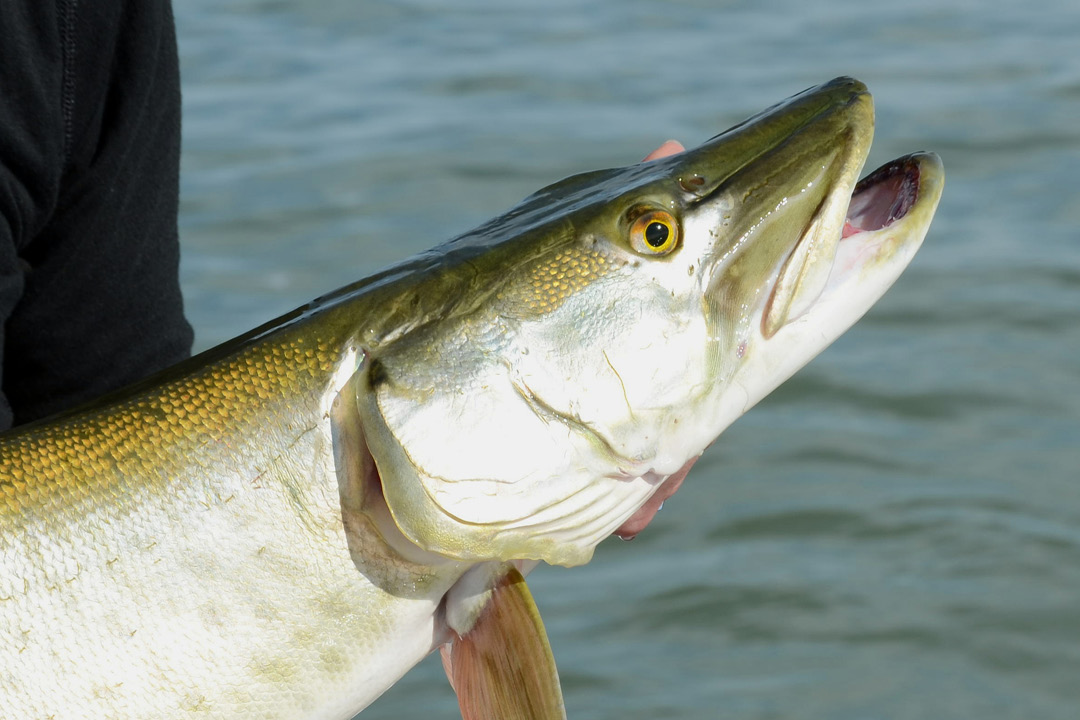CRAPPIE FISHING TECHNIQUES AND TIPS
Fishing | March 27, 2024
Win a trip to Crete by becoming an Explore + member
SAIL
March 9, 2023

Known as “the fish of 1,000 casts,” the muskellunge (aka muskie) is a popular species for anglers in Quebec and Ontario, two provinces offering world-class muskie fishing. Whether you’re fishing in these regions or somewhere else, here’s a review of the essential fishing gear you need for catching and releasing muskie.
In this article, you will learn more about muskie fishing:
The muskie is an apex predator. Its diet consists mainly of fish, suckers and ciscoes being two favourites, but muskellunge will also eat frogs, ducklings and rodents if given a chance.
Muskellunge have an elongated shape and are capable of growing quite large. Part of the allure of fishing for muskie is the potential of catching a trophy-sized fish, which for many anglers means landing a fish measuring at least 50 inches.
Muskies commonly feed by ambushing their prey. Attacks typically involve short, fast bursts of intense speed and power. Given this, it’s critical to use strong gear suitable for quickly taming these big, strong fish. The last thing you want is to be fishing for muskellunge with underpowered equipment. With this in mind, here are some things to think about when choosing rods, reels, lines and leaders for muskie fishing.
A heavy or extra-heavy casting rod made specifically for muskie fishing is a must-have. Many muskie anglers prefer long rods measuring eight feet or more. Using a long rod improves casting distance, reduces angler fatigue when casting heavy baits all day, improves boat-side maneuvers like figure-8s, and provides increased leverage and control when battling fish. Some examples of muskie rods are St. Croix’s Mojo and Premier Musky Baitcasting rods, and Okuma’s Psycho Stick.
You need a strong, durable baitcasting reel built to handle fishing with heavy baits and fighting large, powerful muskies. The reel should have a large spool to hold plenty of line and max drag of at least 15 pounds. Many anglers also like a reel with a fast gear ratio (e.g., 7.1:1 or more) in order to bring in line quickly when retrieving baits, setting the hook and playing fish.
The Daiwa Lexa WN and the Komodo SS are examples of baitcasting reels made for muskie fishing. Anglers who regularly troll may want to invest in a rock-solid trolling reel with a line counter.
Strong, no-stretch braided line, such as PowerPro, between 80- to 100-pound test is a reliable choice for many muskie fishing scenarios. Braid should then be tied to a wire or fluorocarbon leader of at least 100-pound-test to prevent bite-offs from toothy muskies.
When buying lures for a muskie tackle box, it’s a good idea to start with some tried-and-true baits representing a few different lure categories. Here are a few muskie lures to consider:
When fishing for muskies, keep in mind these fish are ambush predators who often lurk around the edges. Given this, try to think like a muskie and look for places suitable for their style of feeding. Then cast and retrieve your lure through these zones. For instance, be sure to look for openings in vegetation and weedline edges in lakes and rivers. If fishing deep, northern lakes with little vegetation, focus on rocky points, reefs, islands and saddles.
Anglers can use several of the lures mentioned above to troll for muskie. A muskie-sized spinnerbait or a big spoon are great options for trolling over and along weed beds in summer and early fall, for instance. Trolling diving hard baits around points, saddles, rocky reefs, islands and in front of tributaries will also catch muskie throughout the season.
Experimenting with speed and using turns is important when trolling. These types of changes add variety to a lure’s movement and help trigger strikes from muskellunge.
A fishfinder/chartplotter combo is an important item for muskie fishing. The sonar helps you determine bottom depth. It also displays location of vegetation, structural features and fish within the water column.
The GPS features of a chartplotter, combined with digital lake maps showing bottom contours are also useful for finding muskie fishing spots. Save good fishing spots as GPS waypoints so you can return to them easily in the future. The trail feature on a chartplotter is good to use for improving boat control and trolling precision.
Proper catch and release tools are other muskie fishing essentials. A big, deep net with coated mesh is necessary for landing and keeping a big muskellunge in the water beside the boat. Long-handled or pistol grip fishing pliers are must-haves for removing hooks, and sometimes it’s faster to use cutters to snip and remove stubborn hooks. A fish mouth opener (aka jaw spreader) is equally important to carry. Wearing fish-handling gloves can protect hands from cuts, but be sure to wet them before handling a muskie.
In addition to owning the right tools, anglers must follow proper hook removal techniques and fish-handling procedures to help sustain the world-class muskellunge fisheries found in Quebec and Ontario. Muskies Canada (muskiescanada.ca) is a good resource for learning more about these important concepts and practices.
Fishing for muskellunge is challenging, and opportunities to catch these elusive fish can be few and far between. Gear up with the right equipment, and you’ll be well prepared and poised to seize the opportunity when a big muskie strikes your lure.